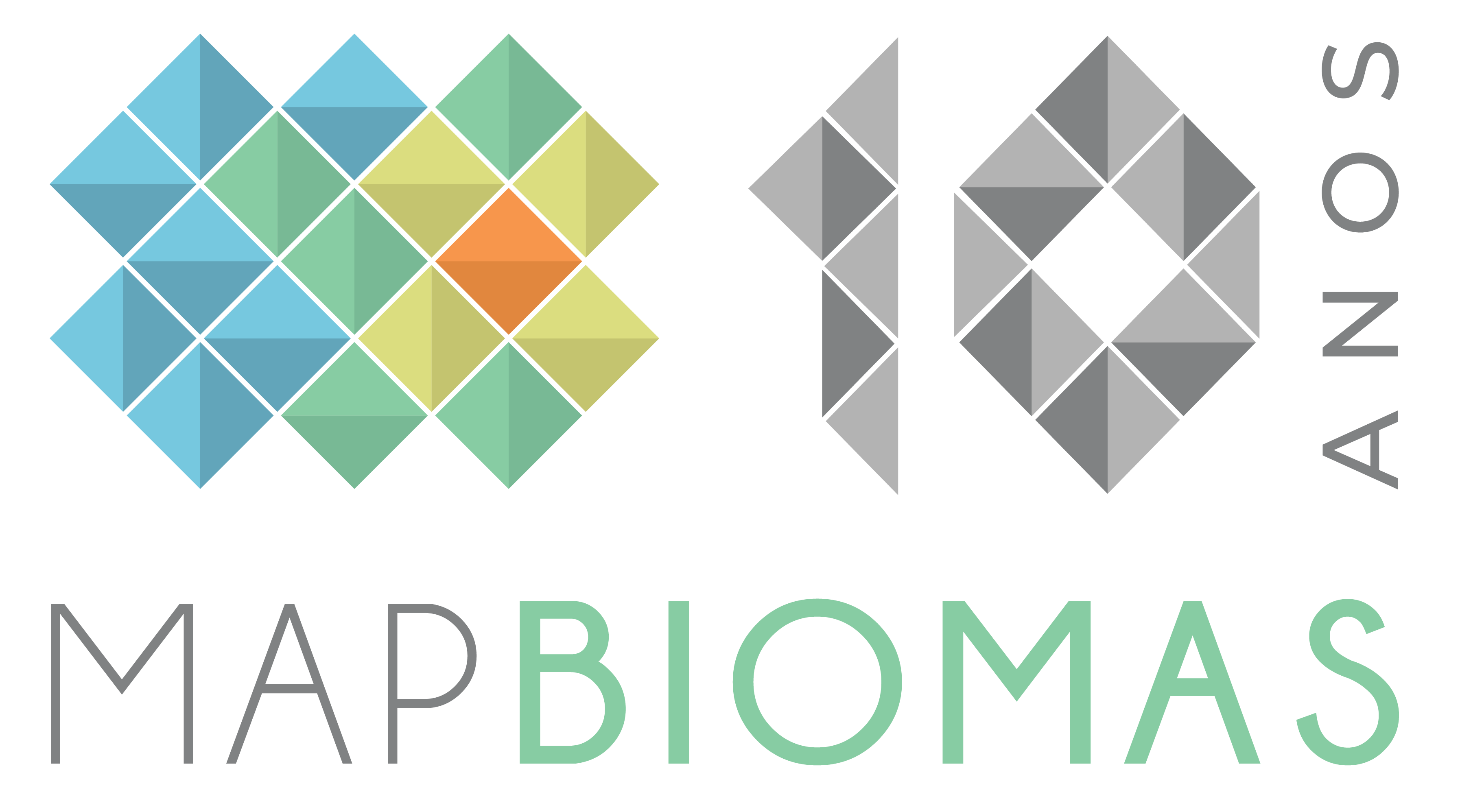From the Landsat mosaics, the classifications that result in land cover and land use maps are carried out for each year. Within the logic proposed by MapBiomas the maps will be updated every time there is an improvement in the classification algorithms. The classification methodology is dynamic and procedural, with the purpose of improving the classification of each typology.
Os mapas das coleções mais atuais do MapBiomas podem ser acessados de quatro formas:
.aagb__accordion_container.no-pro-plan .aagb__accordion_body { padding: 10px !important; }jQuery(document).ready(function($) { var text_max = parseInt(“1”); // Parse contentCount as an integer $(“.expand .aagb__accordion_component p”).hide(); $(“.expand .aagb__accordion_component p”).slice(0, text_max).show(); $(“.expand .aagb_button_toggle”).click(function(e) { e.preventDefault(); $(“.expand .aagb__accordion_component p:hidden”).slice(0, text_max).fadeIn(“slow”); if ($(“.expand .aagb__accordion_component p:hidden”).length === 0) { $(“.aagb_button_toggle”).fadeOut(“slow”); $(“.aagb_overlay”).fadeOut(“slow”); } }); }); .aagb__accordion_container.no-pro-plan .aagb__accordion_body { padding: 10px !important; }1. browsing on line through the MapBiomas dashboard:
✓jQuery(document).ready(function($) { var text_max = parseInt(“1”); // Parse contentCount as an integer $(“.expand .aagb__accordion_component p”).hide(); $(“.expand .aagb__accordion_component p”).slice(0, text_max).show(); $(“.expand .aagb_button_toggle”).click(function(e) { e.preventDefault(); $(“.expand .aagb__accordion_component p:hidden”).slice(0, text_max).fadeIn(“slow”); if ($(“.expand .aagb__accordion_component p:hidden”).length === 0) { $(“.aagb_button_toggle”).fadeOut(“slow”); $(“.aagb_overlay”).fadeOut(“slow”); } }); }); .aagb__accordion_container.no-pro-plan .aagb__accordion_body { padding: 10px !important; }2. Download por estado, bioma, município e qualquer outra geometria desejada por meio dos Toolkits preparados no Google Earth Engine (GEE).
✓This tool has the advantage of exporting both the map and area statistics for the selected geometries and periods. Access the tutorial video to learn how to use the toolkit. Instructions are also available on Github. The following data are currently available:
jQuery(document).ready(function($) { var text_max = parseInt(“1”); // Parse contentCount as an integer $(“.expand .aagb__accordion_component p”).hide(); $(“.expand .aagb__accordion_component p”).slice(0, text_max).show(); $(“.expand .aagb_button_toggle”).click(function(e) { e.preventDefault(); $(“.expand .aagb__accordion_component p:hidden”).slice(0, text_max).fadeIn(“slow”); if ($(“.expand .aagb__accordion_component p:hidden”).length === 0) { $(“.aagb_button_toggle”).fadeOut(“slow”); $(“.aagb_overlay”).fadeOut(“slow”); } }); }); .aagb__accordion_container.no-pro-plan .aagb__accordion_body { padding: 10px !important; }3. acessar o data asset on Google Earth Engine: ID:
✓
- Land cover and use, Transition, Deforestation and Secondary Vegetation and Secondary Vegetatiton Age (Collection 9)
projects/mapbiomas-public/assets/brazil/lulc/collection9/mapbiomas_collection90_integration_v1 (see GEE code example)
projects/mapbiomas-public/assets/brazil/lulc/collection9/mapbiomas_collection90_transitions_v1
projects/mapbiomas-public/assets/brazil/lulc/collection9/mapbiomas_collection90_deforestation_secondary_vegetation_v1 (veja código)
projects/mapbiomas-public/assets/brazil/lulc/collection9/mapbiomas_collection90_secondary_vegetation_age_v1 (veja de código no GEE)
- Módulo da Agricultura (Collection 9)
projects/mapbiomas-public/assets/brazil/lulc/collection9/mapbiomas_collection90_irrigated_agriculture_v1 (veja código)
projects/mapbiomas-public/assets/brazil/lulc_10m/collection2/mapbiomas_10m_collection2_agriculture_number_cycles_v1 (código)
projects/mapbiomas-public/assets/brazil/lulc_10m/collection2/mapbiomas_10m_collection2_agriculture_mean_cycles_2017_2023_v1 (ex.)
- Mining (Industrial, Mining, and Main Mineral Substance) (Collection 9)
projects/mapbiomas-public/assets/brazil/lulc/collection9/mapbiomas_collection90_mined_substance_v1
- Módulo da Pastagem (Collection 9)
projects/mapbiomas-public/assets/brazil/lulc/collection9/mapbiomas_collection90_pasture_vigor_v1 (see GEE code example)
projects/mapbiomas-public/assets/brazil/lulc/collection9/mapbiomas_collection90_pasture_vigor_transition_v1
projects/mapbiomas-public/assets/brazil/lulc/collection9/mapbiomas_collection90_pasture_age_v1 (see GEE code example)
projects/mapbiomas-public/assets/brazil/lulc/collection9/mapbiomas_collection90_pasture_detection_year_v1 (veja exemplo de código)
projects/mapbiomas-public/assets/brazil/lulc/collection9/mapbiomas_collection90_pasture_gpp_v1 (see GEE code example)
projects/mapbiomas-public/assets/brazil/lulc/collection9/mapbiomas_collection90_pasture_last_time_mapped_v1 (veja exemplo de código)
- MapBiomas Water (collection 3)
projects/mapbiomas-public/assets/brazil/water/collection3/mapbiomas_water_annual_water_coverage_v1
projects/mapbiomas-public/assets/brazil/water/collection3/mapbiomas_water_frequency_v1
- Annual and cumulative burned area and cover (collection 3)
projects/mapbiomas-public/assets/brazil/fire/collection3/mapbiomas_fire_collection3_annual_burned_v1
projects/mapbiomas-public/assets/brazil/fire/collection3/mapbiomas_fire_collection3_annual_burned_coverage_v1
projects/mapbiomas-public/assets/brazil/fire/collection3/mapbiomas_fire_collection3_accumulated_burned_v1
projects/mapbiomas-public/assets/brazil/fire/collection3/mapbiomas_fire_collection3_accumulated_burned_coverage_v1
- MapBiomas Fire (coleção 4)
Annual and cumulative burned area and cover
projects/mapbiomas-public/assets/brazil/fire/collection4/mapbiomas_fire_collection4_annual_burned_v1
projects/mapbiomas-public/assets/brazil/fire/collection4/mapbiomas_fire_collection4_annual_burned_vectors_v1/mbfogo_col4_2024_v1 [vetorial (uma FeatureCollection por ano entre 1985 e 2024)]
projects/mapbiomas-public/assets/brazil/fire/collection4/mapbiomas_fire_collection4_annual_burned_coverage_v1
projects/mapbiomas-public/assets/brazil/fire/collection4/mapbiomas_fire_collection4_accumulated_burned_v1
projects/mapbiomas-public/assets/brazil/fire/collection4/mapbiomas_fire_collection4_accumulated_burned_coverage_v1Monthly burned area
projects/mapbiomas-public/assets/brazil/fire/collection4/mapbiomas_fire_collection4_monthly_burned_v1Annual Burned Area by Scar Size, Frequency, and Last Fire Year
projects/mapbiomas-public/assets/brazil/fire/collection4/mapbiomas_fire_collection4_annual_burned_scar_size_range_v1
projects/mapbiomas-public/assets/brazil/fire/collection4/mapbiomas_fire_collection4_fire_frequency_v1
projects/mapbiomas-public/assets/brazil/fire/collection4/mapbiomas_fire_collection4_year_last_fire_v1Área queimada mensal (Monitor do Fogo)
projects/mapbiomas-public/assets/brazil/fire/monitor/mapbiomas_fire_monthly_burned_v1
- Cover and use 10 meters (beta collection)
projects/mapbiomas-public/assets/brazil/lulc_10m/collection2/mapbiomas_10m_collection2_integration_v1
- Soil (coleção 2 beta)
Carbono no Solo
projects/mapbiomas-public/assets/brazil/soil/collection2/mapbiomas_soil_collection2_soc_kgc_m2_000_030cm
projects/mapbiomas-public/assets/brazil/soil/collection2/mapbiomas_soil_collection2_soc_tc_ha_000_030cm
projects/mapbiomas-public/assets/brazil/soil/collection2/mapbiomas_soil_collection2_soc_tc_ha_000_030cm_coverage
projects/mapbiomas-public/assets/brazil/soil/collection2/mapbiomas_soil_collection2_socsoc_tc_ha_000_030cm_coverageTextura do Solo
projects/mapbiomas-public/assets/brazil/soil/collection2/mapbiomas_soil_collection2_granulometry_clay_percentage
projects/mapbiomas-public/assets/brazil/soil/collection2/mapbiomas_soil_collection2_granulometry_sand_percentage
projects/mapbiomas-public/assets/brazil/soil/collection2/mapbiomas_soil_collection2_granulometry_silt_percentage
projects/mapbiomas-public/assets/brazil/soil/collection2/mapbiomas_soil_collection2_textural_classes
projects/mapbiomas-public/assets/brazil/soil/collection2/mapbiomas_soil_collection2_textural_groups
projects/mapbiomas-public/assets/brazil/soil/collection2/mapbiomas_soil_collection2_textural_subgroups
projects/mapbiomas-public/assets/brazil/soil/collection2/mapbiomas_soil_collection2_textural_triangule
- Módulo Urbano : consulte mais informações sobre como baixar os dados do módulo urbano here
jQuery(document).ready(function($) { var text_max = parseInt(“1”); // Parse contentCount as an integer $(“.expand .aagb__accordion_component p”).hide(); $(“.expand .aagb__accordion_component p”).slice(0, text_max).show(); $(“.expand .aagb_button_toggle”).click(function(e) { e.preventDefault(); $(“.expand .aagb__accordion_component p:hidden”).slice(0, text_max).fadeIn(“slow”); if ($(“.expand .aagb__accordion_component p:hidden”).length === 0) { $(“.aagb_button_toggle”).fadeOut(“slow”); $(“.aagb_overlay”).fadeOut(“slow”); } }); });4. Download direto de todo o Brasil em formato GeoTiff (um mapa para cada ano). Para os demais anos basta trocar o ano no link
✓
- Cobertura e Uso da Terra (Coleção 9) :
Uso e Cobertura (1985 a 2023)
https://storage.googleapis.com/mapbiomas-public/initiatives/brasil/collection_9/lclu/coverage/brasil_coverage_2023.tifDesmatamento (coleção 9 – 1986 a 2023)
https://storage.googleapis.com/mapbiomas-public/initiatives/brasil/collection_9/lulc-1/deforestation-1/mapbiomas_collection90_deforestation_secondary_vegetation_v1/mapbiomas_collection90_deforestation_secondary_vegetation_v1-classification_2023.tifDeforestation accumulated are available for 1986-2023, 2000-2023 and 2008-2023
https://storage.googleapis.com/mapbiomas-public/initiatives/brasil/collection_9/lulc-1/deforestation-1/mapbiomas_collection90_def_sec_veg_accumulated_v1/mapbiomas_collection90_def_sec_veg_accumulated_v1-deforestation_accumulated_1986_2023.tifSecundary Vegetation accumulated are available for 1986-2023, 2000-2023 and 2008-2023
https://storage.googleapis.com/mapbiomas-public/initiatives/brasil/collection_9/lulc-1/deforestation-1/mapbiomas_collection90_def_sec_veg_accumulated_v1/mapbiomas_collection90_def_sec_veg_accumulated_v1-secondary_vegetation_accumulated_1986_2023.tifIdade da Vegetação Secundária (coleção 9 – 1985 a 2023)
https://storage.googleapis.com/mapbiomas-public/initiatives/brasil/collection_9/lulc-1/sec-veg-1/mapbiomas_collection90_secondary_vegetation_age_v1/mapbiomas_collection90_secondary_vegetation_age_v1-secondary_vegetation_age_2023.tifCobertura e Uso 10 metros (coleção 2 beta)
https://storage.googleapis.com/mapbiomas-public/initiatives/brasil/lulc_10m/collection_2/integration/mapbiomas_10m_collection2_integration_v1-classification_2023.tifIrrigação (coleção 9 – 1985 a 2023)
https://storage.googleapis.com/mapbiomas-public/initiatives/brasil/collection_9/agriculture-1/mapbiomas_collection90_irrigated_agriculture_v1/mapbiomas_collection90_irrigated_agriculture_v1-irrigated_agriculture_2023.tifMineração (Industrial, Garimpo e Substância mineral princial) (coleção 9) (em processamento)
- Módulo da Pastagem (coleção 9)
Vigor
https://storage.googleapis.com/mapbiomas-public/initiatives/brasil/collection_9/pasture-1/mapbiomas_collection90_pasture_vigor_v1/mapbiomas_collection90_pasture_vigor_v1-vigor_2023.tifProdutividade
https://storage.googleapis.com/mapbiomas-public/initiatives/brasil/collection_9/pasture-1/mapbiomas_collection90_pasture_gpp_v1/mapbiomas_collection90_pasture_gpp_v1-gpp_2022.tifIdade
https://storage.googleapis.com/mapbiomas-public/initiatives/brasil/collection_9/pasture-1/mapbiomas_collection90_pasture_age_v1/mapbiomas_collection90_pasture_age_v1-age_2023.tifPrimeiro ano de mapeamento
https://storage.googleapis.com/mapbiomas-public/initiatives/brasil/collection_9/pasture-1/mapbiomas_collection90_pasture_detection_year_v1/mapbiomas_collection90_pasture_detection_year_v1-first_time_pasture.tifÚltimo ano mapeado com pastagem/ano de conversão
https://storage.googleapis.com/mapbiomas-public/initiatives/brasil/collection_9/pasture-1/mapbiomas_collection90_pasture_last_time_mapped_v1/mapbiomas_collection90_pasture_last_time_mapped_v1-last_time_pasture.tif
- MapBiomas Fire
Área e Cobertura queimada Anual e Acumulada (coleção 4)
https://storage.googleapis.com/mapbiomas-public/initiatives/brasil/collection_9/fire-col4/annual_burned/mapbiomas_fire_col4_br_annual_burned_2024.tif
https://storage.googleapis.com/mapbiomas-public/initiatives/brasil/collection_9/fire-col4/annual_burned_vectors_v1/mapbiomas_fire_col4_br_annual_burned_2024.zip
https://storage.googleapis.com/mapbiomas-public/initiatives/brasil/collection_9/fire-col4/annual_burned_coverage_v1/mapbiomas_fire_col4_br_annual_burned_coverage_2024.tif
https://storage.googleapis.com/mapbiomas-public/initiatives/brasil/collection_9/fire-col4/accumulated_burned_v1/mapbiomas_fire_col4_br_accumulated_burned_1985_2024.tif
https://storage.googleapis.com/mapbiomas-public/initiatives/brasil/collection_9/fire col4/accumulated_burned_coverage_v1/mapbiomas_fire_col4_br_accumulated_burned_coverage_1985_2024.tifÁrea queimada mensal (coleção 4)
Área queimada anual por tamanho de cicatriz, frequência e ano do último fogo (coleção 4)
https://storage.googleapis.com/mapbiomas-public/initiatives/brasil/collection_9/fire-col4/annual_burned_scar_size_range_v1/mapbiomas_fire_col4_br_annual_burned_scar_size_range_2024.tif
https://storage.googleapis.com/mapbiomas-public/initiatives/brasil/collection_9/fire-col4/year_last_fire_v1/mapbiomas_fire_col4_br_year_last_fire_2024.tif
https://storage.googleapis.com/mapbiomas-public/initiatives/brasil/collection_9/fire-col4/fire_frequency_v1/mapbiomas_fire_col4_br_fire_frequency_1985_2024.tif
- MapBiomas Solo (coleção 2 beta)
Estoque de Carbono Orgânico no Solo (Beta – 1985 a 2023)
https://storage.googleapis.com/mapbiomas-public/initiatives/brasil/collection_9/soil_2/mbsoil_c02_soc_t_ha_000_030cm/mbsoil_c02_soc_t_ha_000_030cm_prediction_2023.tifGranulometria – Argila (%)
[0-10cm] | https://storage.googleapis.com/mapbiomas-public/initiatives/brasil/collection_9/soil_2/mbsoil_c02_granulometry_clay_percent/mbsoil_c02_granulometry_clay_percent_clay_000_010cm.tif
[0-20cm] | https://storage.googleapis.com/mapbiomas-public/initiatives/brasil/collection_9/soil_2/mbsoil_c02_granulometry_clay_percent/mbsoil_c02_granulometry_clay_percent_clay_000_020cm.tif
[0-30cm] | https://storage.googleapis.com/mapbiomas-public/initiatives/brasil/collection_9/soil_2/mbsoil_c02_granulometry_clay_percent/mbsoil_c02_granulometry_clay_percent_clay_000_030cm.tif
[10-20cm] | https://storage.googleapis.com/mapbiomas-public/initiatives/brasil/collection_9/soil_2/mbsoil_c02_granulometry_clay_percent/mbsoil_c02_granulometry_clay_percent_clay_010_020cm.tif
[20-30cm] | https://storage.googleapis.com/mapbiomas-public/initiatives/brasil/collection_9/soil_2/mbsoil_c02_granulometry_clay_percent/mbsoil_c02_granulometry_clay_percent_clay_020_030cm.tifGranulometria – Areia (%)
[0-10cm] | https://storage.googleapis.com/mapbiomas-public/initiatives/brasil/collection_9/soil_2/mbsoil_c02_granulometry_sand_percent/mbsoil_c02_granulometry_sand_percent_sand_000_010cm.tif
[0-20cm] | https://storage.googleapis.com/mapbiomas-public/initiatives/brasil/collection_9/soil_2/mbsoil_c02_granulometry_sand_percent/mbsoil_c02_granulometry_sand_percent_sand_000_020cm.tif
[0-30cm] | https://storage.googleapis.com/mapbiomas-public/initiatives/brasil/collection_9/soil_2/mbsoil_c02_granulometry_sand_percent/mbsoil_c02_granulometry_sand_percent_sand_000_030cm.tif
[10-20cm] | https://storage.googleapis.com/mapbiomas-public/initiatives/brasil/collection_9/soil_2/mbsoil_c02_granulometry_sand_percent/mbsoil_c02_granulometry_sand_percent_sand_010_020cm.tif
[20-30cm] | https://storage.googleapis.com/mapbiomas-public/initiatives/brasil/collection_9/soil_2/mbsoil_c02_granulometry_sand_percent/mbsoil_c02_granulometry_sand_percent_sand_020_030cm.tifGranulometria – Silte (%)
[0-10cm] | https://storage.googleapis.com/mapbiomas-public/initiatives/brasil/collection_9/soil_2/mbsoil_c02_granulometry_silt_percent/mbsoil_c02_granulometry_silt_percent_silt_000_010cm.tif
[0-20cm] | https://storage.googleapis.com/mapbiomas-public/initiatives/brasil/collection_9/soil_2/mbsoil_c02_granulometry_silt_percent/mbsoil_c02_granulometry_silt_percent_silt_000_020cm.tif
[0-30cm] | https://storage.googleapis.com/mapbiomas-public/initiatives/brasil/collection_9/soil_2/mbsoil_c02_granulometry_silt_percent/mbsoil_c02_granulometry_silt_percent_silt_000_030cm.tif
[10-20cm] | https://storage.googleapis.com/mapbiomas-public/initiatives/brasil/collection_9/soil_2/mbsoil_c02_granulometry_silt_percent/mbsoil_c02_granulometry_silt_percent_silt_010_020cm.tifSubgrupos Texturais
[0-10cm] | https://storage.googleapis.com/mapbiomas-public/initiatives/brasil/collection_9/soil_2/mbsoil_c02_textural_subgroups/mbsoil_c02_textural_subgroups_000_010cm.tif
[0-20cm] | https://storage.googleapis.com/mapbiomas-public/initiatives/brasil/collection_9/soil_2/mbsoil_c02_textural_subgroups/mbsoil_c02_textural_subgroups_000_020cm.tif
[0-30cm] | https://storage.googleapis.com/mapbiomas-public/initiatives/brasil/collection_9/soil_2/mbsoil_c02_textural_subgroups/mbsoil_c02_textural_subgroups_000_030cm.tifGrupos Texturais
[0-10cm] | https://storage.googleapis.com/mapbiomas-public/initiatives/brasil/collection_9/soil_2/mbsoil_c02_textural_groups/mbsoil_c02_textural_groups_000_010cm.tif
[0-20cm] | https://storage.googleapis.com/mapbiomas-public/initiatives/brasil/collection_9/soil_2/mbsoil_c02_textural_groups/mbsoil_c02_textural_groups_000_020cm.tif
[0-30cm] | https://storage.googleapis.com/mapbiomas-public/initiatives/brasil/collection_9/soil_2/mbsoil_c02_textural_groups/mbsoil_c02_textural_groups_000_030cm.tifClasses Texturais
[0-10cm] | https://storage.googleapis.com/mapbiomas-public/initiatives/brasil/collection_9/soil_2/mbsoil_c02_textural_classes/mbsoil_c02_textural_classes_000_010cm.tif
[0-20cm] | https://storage.googleapis.com/mapbiomas-public/initiatives/brasil/collection_9/soil_2/mbsoil_c02_textural_classes/mbsoil_c02_textural_classes_000_020cm.tif
[0-30cm] | https://storage.googleapis.com/mapbiomas-public/initiatives/brasil/collection_9/soil_2/mbsoil_c02_textural_classes/mbsoil_c02_textural_classes_000_030cm.tiflet aagb_group_accordion_text_max = 100

